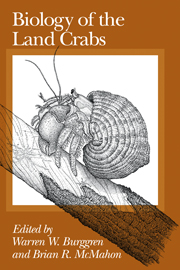Book contents
- Frontmatter
- Contents
- List of contributors
- Preface
- 1 BIOLOGY OF THE LAND CRABS: AN INTRODUCTION
- 2 EVOLUTION, SYSTEMATICS, AND GEOGRAPHICAL DISTRIBUTION
- 3 ECOLOGY
- 4 BEHAVIOR
- 5 REPRODUCTION AND DEVELOPMENT
- 6 GROWTH AND MOLTING
- 7 ION AND WATER BALANCE
- 8 RESPIRATION
- 9 CIRCULATION
- 10 ENERGETICS AND LOCOMOTION
- 11 EPILOGUE
- APPENDIX: Natural histories of selected terrestrial crabs
- References
- Author index
- Systematic index
- Subject index
11 - EPILOGUE
Published online by Cambridge University Press: 04 August 2010
- Frontmatter
- Contents
- List of contributors
- Preface
- 1 BIOLOGY OF THE LAND CRABS: AN INTRODUCTION
- 2 EVOLUTION, SYSTEMATICS, AND GEOGRAPHICAL DISTRIBUTION
- 3 ECOLOGY
- 4 BEHAVIOR
- 5 REPRODUCTION AND DEVELOPMENT
- 6 GROWTH AND MOLTING
- 7 ION AND WATER BALANCE
- 8 RESPIRATION
- 9 CIRCULATION
- 10 ENERGETICS AND LOCOMOTION
- 11 EPILOGUE
- APPENDIX: Natural histories of selected terrestrial crabs
- References
- Author index
- Systematic index
- Subject index
Summary
As intended, this book has gathered a wealth of information concerning many aspects of the biology of land crabs. Most chapters have taken a comparative approach, often starting with the biology of aquatic crabs and showing how the development of morphological, physiological, and behavioral characters have allowed penetration into, and eventual colonization of, the terrestrial habitat. One of the goals of the editors in planning this book was to seek a better understanding of the evolution of terrestriality within decapods. Thus, a reexamination of this evolutionary trend will serve as a suitable epilogue.
From examination of this book's chapters it is clear that, under the descriptor “land crabs, ” the various contributors have considered many different groups of crabs. These groups vary considerably both in the terrestrial adaptations they exhibit as well as in their ability to move into the terrestrial habitat. The “failure” to achieve a clear definition of what constitutes a “land crab” is, in fact, no disadvantage, for it correctly causes us to focus on a continuum of crabs showing progressively greater levels of terrestrial adaptation. An approach that examines a continuum of species not only enhances understanding of the evolution of terrestriality in the land crabs, but may also provide insights into the radiations of protoinsects and vertebrates.
Terrestrial crabs appeared only in relatively recent geologic times, especially when compared with the land colonization by vertebrates or protoinsects. Although fossil evidence is extremely sparse, families of crabs with living species in terrestrial habitats appear in the fossil record no earlier than the Paleocene or late Cretaceous (Chapter 2).
- Type
- Chapter
- Information
- Biology of the Land Crabs , pp. 378 - 381Publisher: Cambridge University PressPrint publication year: 1988

